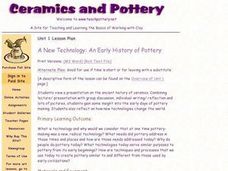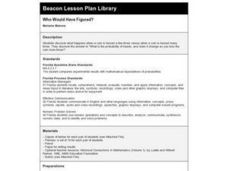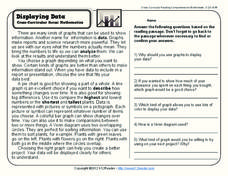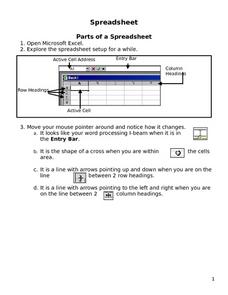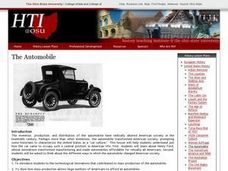Curated OER
Traveling the Transcontinental from Yesterday to Today
High schoolers examine the impact of the train on the physical landscape and spatial organization of America. They read and analyze various poems, analyze maps, and develop a list of the positive and negative changes brought by the...
Curated OER
Picture a Nation
Students research immigration data from a specific time period. They create a graphic organizer that depicts the information and share the information with the class.
Curated OER
A New Technology: An Early History of Pottery
Students view a presentation on the ancient history of ceramics and gain insight into the early days of pottery making. They also reflect on how new technologies change the world.
Curated OER
Finding the Salt Front
Students discuss definitions of estuary, salinity, and the salt front. They listen as the teacher explains the Hudson River Miles and ways the upriver and downriver sections relate to the north and south. Students graph the salt front...
Curated OER
Artificial Selection
The second lesson in the series begins with a starter activity discussing wild versus domesticated animals. Then, scholars play a card game, with optional variations, to emphasize artificial selection. Next, they attend a field trip to a...
Curated OER
Great River Bend Adventure
Young scholars use their imagination. They discuss the 4 C's of teamwork: Concentration, Communications, Coomperation, and Consideration. Students discuss the safety guidelines of the project. They complete a rope maze. The group walks...
Curated OER
Who Would Have Figured?
Students investigate what happens when a coin is tossed a few times versus many times. They analyze, in groups, the data from tossing coins, and the Law of Large Numbers.
Curated OER
Britian of the Future
Learners explore the issues touched on in the programme extracts and generate ideas about what Britian might look like in the future. They develop a picture of this imagined England and explore how the relationship between Scotland,...
Curated OER
People Movers
Students think about rapid transit systems and to design one for the kids in their own community. They start off with a discussion of the New York City subway system: why it was built, how it was built, how it changed the city.
Curated OER
Test Your Speaking and Listening Skills: Role Play-Shopping: ESL
In this ESL role playing worksheet, students role play taking merchandise back to a store. Students read 9 lines of script, a conversation between 2 students.
Curated OER
Investigating Newton's Second Law Of Motion
Students participate in a lesson plan that investigates Newton's Second Law of Motion. They conduct an experiment of observing balls that are rolled down a ramp. The lesson plan includes background information for the teacher for...
K12 Reader
Displaying Data
It's important to learn how to display data to make the information easier for people to understand. A reading activity prompts kids to use context clues to answer five comprehension questions after reading several paragraphs about...
Virginia Department of Education
A-Mazing Plants
Have your young scientists questioned why plants grow a particular way? Through this learning opportunity, scientists gain firsthand knowledge about how plants develop and various factors that affect rates of growth as they bring plants...
National Wildlife Federation
What is DBH?
When measuring the circumference of a tree, does it matter how high you place the measuring tape? Most scholars have never considered this question, but scientists know that measurement techniques must be standardized. The 13th lesson in...
Curated OER
Lesson 7: Smart Grids
Energy conservation is a hot topic these days; introduce your kids to the Smart Grid solution through a video clip and several interactive online tools. They discuss areas of household energy consumption, examining a pie chart...
Curated OER
What is the Evidence for Evolution?
Middle schoolers identify one object that would tell the story of their lives. In groups, they determine what can and cannot be told from objects left behind. After watching a video, they compare and contrast chicken bones to human...
Curated OER
The Solstices
Compare surface temperatures when the solstice occurs in the different hemispheres. Young scientists draw conclusions from their investigation of data collected using spreadsheets and a globe.
Curated OER
Parts of a Spreadsheet
Learners experiment with the basic functions of a spreadsheet. They practice using headers, footers, functions and fonts. They also organize information.
Curated OER
Let's Graph It
In this let's graph it activity, student interactively answer 10 multiple choice questions about graphing data and types of graphs, then click to check their answers.
Curated OER
It Takes a Community
Third graders examine their own city governments. They investigate the rights and responsibilities of individuals as well as government services in their town. Students invite members of the governing body to speak to the class.
Curated OER
The Automobile
Students are introduced to technological innovations that contributed to mass production of the automobile and how this allows large numbers of Americans to afford an automobile.
Curated OER
Physical Science: Solar Energy
Students review and discuss how Solar energy and electricity produce light and heat. They create a photo/picture journal and include pictures taken during solar energy activities to a PowerPoint slide presentation.
Curated OER
Patriots of the Revolution
Fifth graders identify causes and effects of historical events in the American Revolution. They evaluate critical issues and events that led to the American Revolution. Analyze the views and lives of people of the Revolutionary Period.
Curated OER
Real Misleading Graphs
Students identify real graphs and misleading graphs. For this algebra lesson, students surf the Internet for real life scenarios where graphs are used in a misleading way as well as in a correct way.




